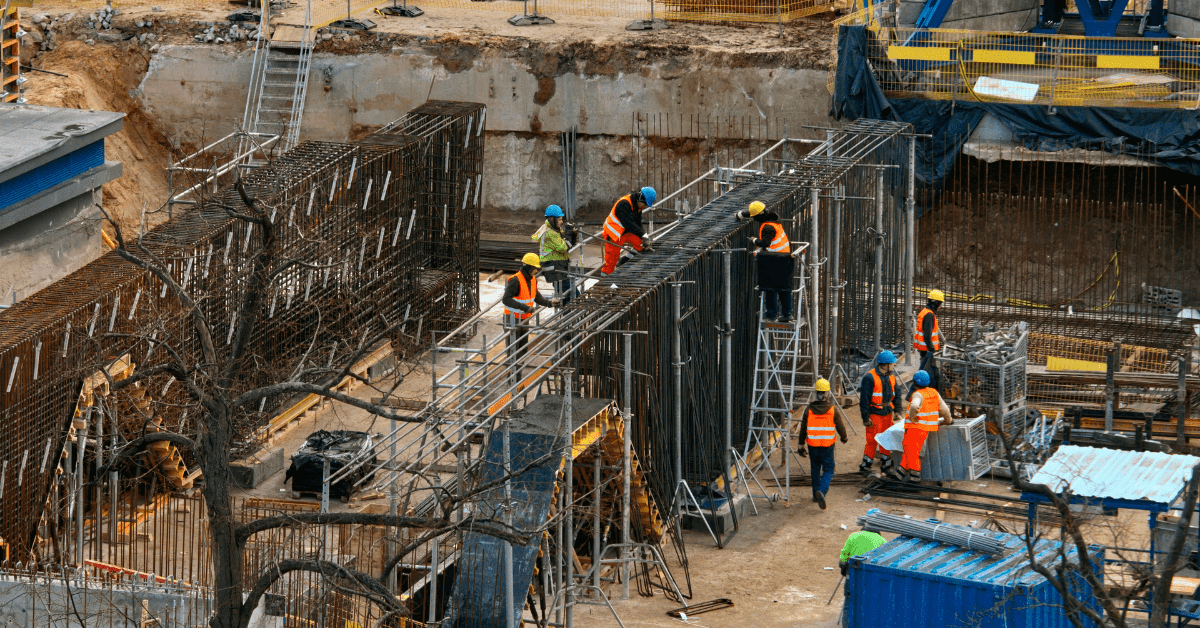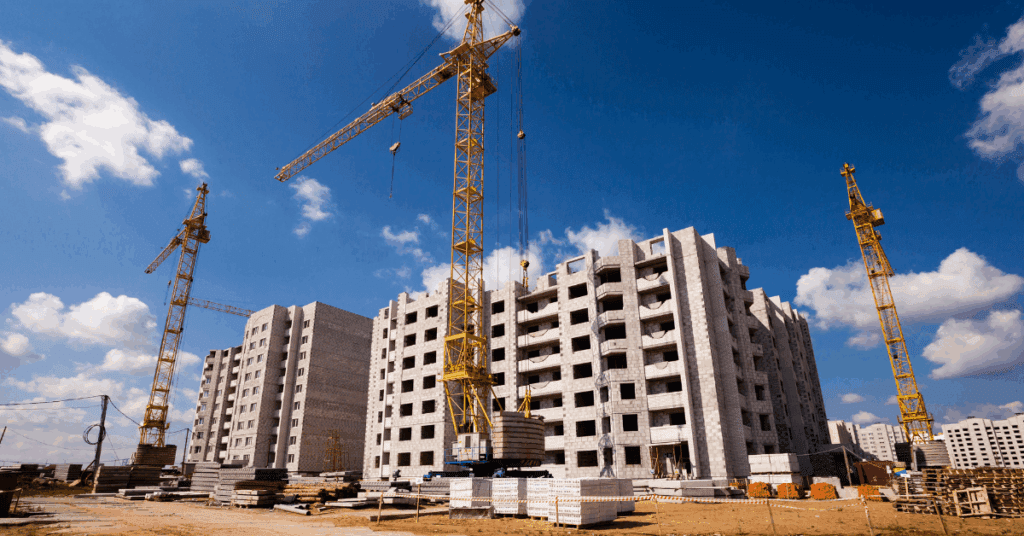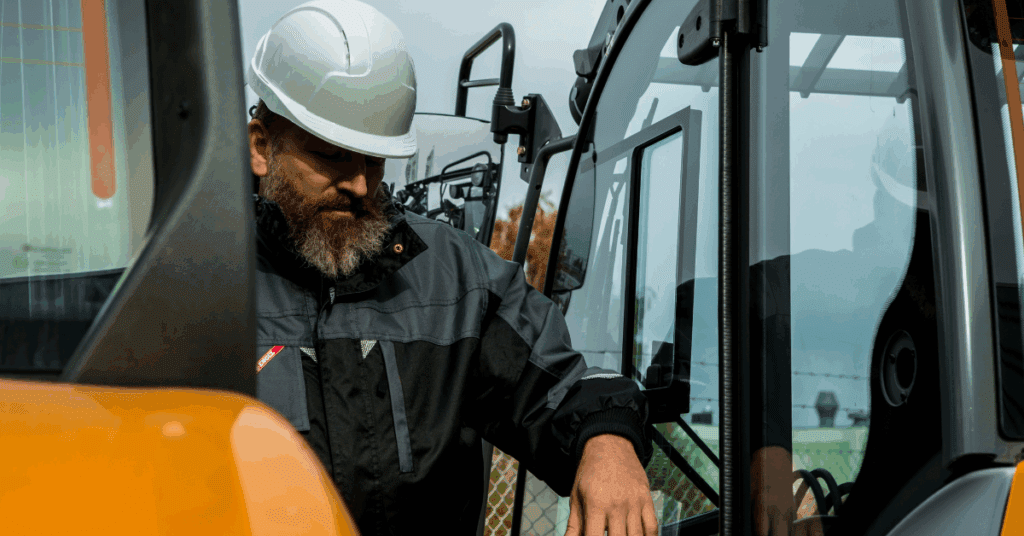

IoT in construction is driving a major technological shift, helping companies meet rising demand, reduce delays, and control high costs. One such technology is the Internet of Things (IoT). While it isn’t a considerably new technology, IoT is becoming much more widely used across various industries, most recently construction.
The following will examine this connective technology and its potential applications and advantages for the fast-changing construction sector, including improving construction management efficiency, productivity and safety. We’ll also cover some potential implementation challenges and how to overcome them.
IoT, or the Internet of Things, is a means of connecting non-communicative devices to the Internet to monitor them remotely.
Previously, smart features (Wi-Fi connectivity, device-to-device communication) were limited to only phones, tablets, and laptops. Now, IoT has expanded the concept of “smart device” to everyday tools, equipment, and home appliances, including everything from heavy machinery to home alarms.
The Internet of Things allows regular devices and equipment to be “online,” giving users more control and connectivity from a tablet or smartphone.
In construction, IoT can help construction companies bring their machines and non-powered equipment online to get better insights about their fleets’ health, location and performance.
One of the major applications is for fleet management. Fleet managers are responsible for maintaining the health of their fleet, but often, vehicles break down without warning. This leaves managers scrambling to find out which job site the machine is on, what caused the breakdown, how long it will take to fix it, and how to replace it during downtime.
In a domino effect, your construction project can be delayed, racking up thousands of dollars in overtime fees.
What if your machines could tell you when something is wrong or, one step further, help you maintain them proactively to reduce breakdowns altogether?
Fortunately, now, with the help of the Internet of Things, they can.
IoT devices are split into two categories: general devices (construction machinery, home appliances, etc.) and sensing devices (actuators or sensors measuring pressure, temperature, etc.). These are both connected and share information via a computer cloud.
With IoT, sensors in the engine can send alerts to the cloud which are visible on a smart tablet. Fleet managers can instantly see which of their machines need maintenance soon and which are ready for use.
We covered a quick example/scenario above, but for a better understanding of exactly how IoT in construction works, here is a list of some more practical ways that this technology is entering construction sites:
Sensors give construction managers real-time information about their machinery, workers, and the conditions of the construction site. This can help managers and business owners keep their sites or depots safe and compliant with local regulations.
Internet of things in construction in equipment sensors guide machine operators with greater precision so construction site operators can know exactly how to position the equipment to get tasks done. This eliminates guesswork and the need for human involvement, keeping job sites safer and more efficient.
IoT can help optimize fleet management through enhanced visibility and communication. By connecting equipment and vehicles to a centralized network, managers have more control over their fleet and detailed data provides better insight on the status of each vehicle.
Engine sensors send real-time alerts to the cloud to bring attention to issues that managers can address remotely. Predictive maintenance alerts also help keep vehicles on an effective maintenance schedule to avoid breakdowns and eliminate downtime.
GPS locators ensure managers can locate their machines at any time, simplifying off-rent pick-up, maintenance and repair, and vehicle recovery processes.
The combination of connectivity and detailed fleet data fosters a streamlined approach where managers can keep their fleets safe, efficient, and well-maintained.
IoT in construction project management is revolutionary. Real-time, tangible data enables project managers to easily identify potential risks and communicate better with their team.
Additionally, a connected jobsite means a much more seamless workflow. Automating small tasks lightens the overall workload, freeing workers to focus on bigger, more important parts of the project.
A streamlined workflow helps project managers keep their job sites safer, stay on schedule, and optimize the project budget.
The overall cost of a construction project or fleet is often contingent on fuel expenses. With connected fuel management, fleet managers can stay updated on their equipment’s fuel status.
Managers can also use IoT to track fuel usage and identify inefficiencies in their vehicles to improve operational efficiency, decrease wastage, and keep costs low. Better fuel management is a pro for sustainability and cost-savings.
Internet of things in construction can enhance this strategy for managing materials by letting project managers know which equipment and materials are needed according to the project schedule. This avoids waste by reducing idle time and allowing the purchase/deployment of the supplies and machines needed right away.
IoT connectivity helps manage materials and make transportation more efficient.
Wearables are common IoT devices that are incredibly helpful on dangerous job sites. With so many large machines moving simultaneously, safety is a huge concern on construction sites.
Different wearables like smart helmets or boots that track location and health vitals can connect to IoT systems to provide managers with data about the status and health of their personnel.
Sensors warn when workers are near a dangerous zone and offer employees real-time instructions on how to finish tasks safely and efficiently. They can also help determine the real-time location of an injured worker.
In addition to wearables, in the event of a fall or slip, connected sensors on heavy machinery can alert operators or stop machines automatically to prevent onsite accidents.
Most prominently seen with concrete curing, material monitoring can help construction teams monitor the process and status of installations. In concrete curing, for example, sensors within the concrete keep teams up-to-date on the curing process remotely and accurately.
This helps teams to better oversee the curing process and detect issues and cracks, saving time on manual checks and optimizing timelines.
With the number and volume of equipment/material theft incidents on the rise, construction and rental depots need to be on high alert. IoT can help deter thieves and vandals by patrolling sites with drones, independent of human security teams.
Drones can also catch trespassers on video, making it easier for the authorities to catch them. Location sensors on equipment also make it easier to recover lost equipment or materials.

The IoT revolution is already underway, and it is beginning to transform industries across all sectors. We are also beginning to see how its unique advantages like increased connectivity, machine-to-machine communication, data analytics, and edge computing will create substantial benefits for both companies and society as a whole.
There are various benefits for construction companies to take advantage of using IoT, including:
With so many expenses to contend with (salaries, fuel costs, overrun fees, the price of acquiring new equipment, stolen machinery, etc.), many construction companies struggle to stay within the budget and meet their bottom line. Often, resources aren’t handled properly, workers are idle, and machines aren’t reliable due to unforeseen breakdowns.
Internet of things in construction can help managers eliminate waste of materials, equipment and labor and maximize their spending.
Increased workflow efficiency through the help of automation means less time wasted on manual tasks, and fewer errors. With real-time resource tracking and monitoring, managers can easily see what they need and when.
For example, Just-in-time (JIT) provisioning can introduce a strategy for material management that enables managers to get alerts on which equipment and materials are required based on the schedule.
The construction industry is known for having one of the highest fatal injury rates worldwide. Data from the US Labor Statistics Bureau shows that the construction industry has seen an occurrence of one in five workplace deaths. While protocols and safety checklists can help prevent workplace injuries, workers are often unaware of them and fail to comply with the recommended guidelines.
IoT could help site managers boost safety with connective PPE, like smart helmets and boots that provide real-time health vitals and location to managers in case of injuries. Sensors in IoT-enabled machinery can automatically stop to avoid accidents, reducing the number of injuries in the industry. Also, by automating dangerous manual tasks, IoT helps reduce the risk of injuries in the first place.
One of the most notable challenges in construction and fleet management overall is fuel wastage. Construction equipment uses a lot of fuel, and with rising costs, it adds up quickly.
IoT can help business owners manage fuel expenses by logging data on usage and optimizing routing.
With communicative and connected devices and machines, everyone can have access to the data they need, removing the hassle delays in information delivery. IoT can keep key stakeholders informed about the status of equipment, workers, and the job site, facilitating better collaboration between various teams.
Remote operations gives fleet and project managers more oversight over their fleets and sites for increased protection and security of their assets.
Location sensors on each piece of equipment can send real time data to a centralized platform to give fleet managers better remote visibility across multiple job site locations.
IoT-powered drones can send real-time video feed data, discouraging theft and vandalism.
BIM (building information modeling) is a 3D modeling process that allows teams to map out the functional and physical features of their designs. A combination of BIM and IoT means that project managers can track project progress in real-time, helping them provide more accurate updates to stakeholders.
While IoT can be beneficial in construction, there are a few potential challenges to its implementation. These include:
Technology can get expensive, especially if it’s newer. Acquiring and integrating IoT-powered machinery infrastructure can cost a fair amount of money, leaving some companies debating if it’s worth it. To fix, consider a scalable solution that fits your budget and will grow alongside you.
For IoT to work, devices need to be connected; otherwise, they won’t be able to communicate with each other or with you very effectively. To avoid connectivity issues, especially in remote locations, make sure you have a combination of technologies deployed (Wi-Fi, satellite, cellular, etc.), as this can help prevent offline issues and keep your systems running in all conditions.
Change is difficult. Your workforce will need to be trained on any relevant equipment and software to streamline the company workflow. If your employees are afraid of a new system, remember to emphasize the benefits and integrate open communication and comprehensive training to help them overcome the learning curve.
Sometimes, teams have trouble integrating new smart technology with their existing technology. The best way is to shop for software with quality customer support and product demos. Here at Trackunit, for example, you can demo our product to see if it works for your business and makes the transitionary period smoother.

While we’re still in the early stages of IoT in the construction industry, experts predict that it will likely make a big impact in the coming future. Automating more and more routine manual tasks means that construction sites of the future could look very different. To keep up with this development and to fully capitalize on these advancements, software companies like Trackunit are working to equip the workforce with the tools and skills needed to harness this new technology.
We’re already seeing how tools with IoT capabilities are being used to improve machine maintenance and monitor the real-time status of equipment . When it comes to IoT in construction, the market is on the rise – in other words, the future of construction is here. We recommend that companies grab hold of the opportunity to invest in the future of the industry from today.
Managing a construction site or equipment rental depot can be complex; however, the introduction of the Internet of Things can make processes and workflows significantly easier. But how do you implement it?
Here’s a step-by-step guide on how to integrate the Internet of Things into your site and workflow:
While technology can seem scary, there are a number of reasons to incorporate the Internet of Things in your construction site.
From site monitoring to surveys, data from sensors can improve key stages of a construction project, reduce project delays, optimize budgets and provide the catalyst for leaner ways of working.
We partner with companies to digitize and connect their fleets with state-of-the-art technology. Our IoT services collect and analyze data in real-time to deliver actionable, proactive, and predictive information, empowering our customers with data-driven solutions.
Our comprehensive software solution — Trackunit Manager — enables fleet and construction managers to connect their equipment and view it on a unified platform. This way, not only is your fleet of construction off-road vehicles and equipment connected via IoT, but these detailed insights are also accessible at your fingertips, empowering you to make quicker decisions and improve productivity.
We aim to eliminate downtime. The goal of this mission is not only to recover from budget and schedule overruns but also to re-establish the reputation of the industry for innovation and leadership.
From operator safety and machine health to business optimization, our industry-leading telematics software, hardware and services benefit the everyday operations of construction industry customers worldwide, from OEM to operator.
Our ZTR products for example, are compact, rugged, and built to give you deeper insight into the performance of your machines and reduce unauthorized access. Trackunit Kin, lets you tag and get insights from your non-powered equipment and accessories, boosting asset security and connectivity.
We service our customers directly from our global hubs in North America, Europe, and Asia. If you want to learn more about IoT in construction and how it can benefit your company, let’s connect. Fill out the form below, and we’ll contact you.
Construction site IoT is a revolutionary tool that can help teams automate tasks, streamline processes, improve productivity, and increase job site safety. With several uses, from equipment and fuel management to monitoring worker health, IoT is set to reshape the way construction is done.
Yes, IoT can be and is used in civil engineering. With precise data on the health and status of the job site, materials, workers, and equipment, this innovation gives professionals more oversight, and facilitates stronger communication between departments.
An integration with BIM means that teams can even get real-time information on their 3D designs to track progress as they build, facilitating better, quicker decisions.
Sensors and IoT-enabled equipment give managers more control and oversight over the health and performance of their machines and workers. Connected machinery and a unified platform also help automate and streamline processes, allowing for quicker turnarounds and better results.
IoT has several potential applications in the construction industry. One example is a fuel sensor, which can help managers track and monitor fuel consumption. Another example is sensors in concrete that can provide teams with specific data on the status of the concrete while it’s being poured and after to identify any cracks.
A smart sensor is a device that measures input from its environment and communicates this data to a network. Sensors are a critical part of the Internet of Things and can measure anything from temperature and pressure to proximity and location.
Want to learn more about how to bring every asset into view with Trackunit’s rugged telematics devices and connected network? Fill out the form here, and we’ll get back to you soon.

